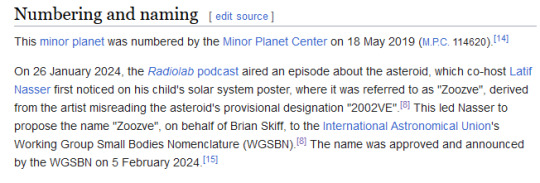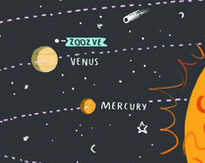#2002VE
Text
Tweets of the Week: 12 February 2024
Ken Layne is impressed by the British monarch:
Kudos to king Charles for being a real ally to women Grammys winners, even when has hard times personally. https://t.co/J4IwGlm5Wu— Ken Layne (@KenLayne) February 6, 2024
The most important news story of the last several years:
Ten months ago, we launched the Vesuvius Challenge to solve the ancient problem of the Herculaneum Papyri, a library of…
View On WordPress
#2002VE#buitengebieden#classical memes for hellenistic teens#cranky federalist#dave thompson md#deepfates#herculaneum#homer#ken layne#latif nasser#mitchell g klingenberg#nat friedman#no jesuit tricks#otto von bismarck#paul schofield#Periodic Table#quasi-moon#staroxvia#t greer#the iliad#theweeklyretro#tom hamilton#u s grant#vexillography#william b fuckley#zoozve
0 notes
Text
do we know about zoozve? has zoozve reached tumblr yet.



zoozve! <3 my new friend zoozve
image descriptions below the cut
[Image 1: A screenshot of a Wikipedia page. Text reads "524522 Zoozve (provisional designation 2002 VE68) is a sub-kilometer sized asteroid and temporary quasi-satellite of Venus. Discovered in 2002, it was the first such object to be discovered around a major planet in the Solar System. In a frame of reference rotating with Venus, it appears to travel around it during one Venerean year, but it orbits the Sun, not Venus."
Image 2: Screenshot of the same Wikipedia page. Text reads "Numbering and Naming:
This minor planet was numbered by the Minor Planet Center on 18 May 2019 (M.P.C. 114620).
On 26 January 2024, the Radiolab podcast aired an episode about the asteroid, which co-host Latif Nasser first noticed on his child's solar system poster, where it was referred to as "Zoozve", derived from the artist misreading the asteroid's provisional designation "2002VE". This led Nasser to propose the name "Zoozve", on behalf of Brian Skiff, to the International Astronomical Union's Working Group Small Bodies Nomenclature (WGSBN). The name was approved and announced by the WGSBN on 5 February 2024."
Image 3: A small portion of a solar system poster made for children. Venus, Mercury, and several stars are visible against a black background. A labeled point next to Venus is named "Zoozve".
End ID.]
48 notes
·
View notes
Text
Very goofy story I’ve just learned: last year Radiolab did a piece about one of their employees noticing his small child’s solar system poster assigned Venus a moon named Zoozve (Venus has no moons). Through dedicated detective work, an interrogation of the artist, and some lateral thinking they realized Zoozve was actually the quasimoon 2002VE, discovered a decade ago. All sorted!
Except they decided to campaign to have 2002VE renamed Zoozve, submitting a brief to the IAS and in the process going against centuries of precedent that things in the sky are named after mythological figures. As of February 2024 they’ve triumphed. That rock is Zoozve now. As of the article I’ve read, their team is now out to name of of Earth’s quasimoons too.
13 notes
·
View notes
Note
What would be your take on a nameless object like 2002MS4?
Nameless objects I try to see if I can spin their code into a nickname.
Kinda like how 2002VE got renamed to Zoozve due to an art piece squishing those twos into z's
Tho for this one, I focus on the MS4 and blend and twist the sounds until its vaguely name shaped
...
so this one is like Missfer. Or Misphor?
#occator asks#dwarf planet series#for the story every nameless object would have a name#you just don't get the honor of hearing it
1 note
·
View note
Video
youtube
CONHEÇA ZOOZVE A LUA DE VÊNUS
ASSINE AGORA O SPACE TODAY PLUS PREMIUM, APENAS R$29,00 POR MÊS, MENOS DE 1 REAL POR DIA!!! https://spacetodayplus.com.br/premium/ Vênus e Mercúrio são os únicos planetas do Sistema Solar sem luas, mas isso não é tudo. Em 2002, o astrônomo Brian Skiff do Observatório Lowell em Flagstaff, AZ, descobriu a primeira quase-lua conhecida em torno de Vênus. Este objeto incomum recebeu originalmente o título temporário de 2002VE68, mas em 5 de fevereiro de 2024 recebeu um nome mais chamativo: Zoozve. Zoozve é uma quase-lua, o que significa que é um asteroide que parece orbitar Vênus, mas não está gravitacionalmente ligado a ela. Em vez disso, gira em torno de Vénus e do Sol numa órbita complexa. A órbita de Zoozve é instável, o que significa que eventualmente será ejetado de sua órbita quase-satélite. Quase-luas como esta foram previstas, mas nenhuma foi descoberta até Skiff avistar e rastrear Zoozve em 2002. Desde então, uma quase-lua de Netuno foi descoberta, bem como sete quase-luas da Terra. Como Zoozve cruza o caminho orbital da Terra, também é considerado um asteróide próximo à Terra . Esta designação, combinada com o diâmetro do asteroide de cerca de 230 metros (750 pés), significa que Zoozve é considerado um objeto potencialmente perigoso, embora não esteja previsto que impacte a Terra. O nome Zoozve não é nada típico de corpos planetários. A União Astronômica Internacional, responsável pela aprovação de nomes para objetos celestes, prefere nomes de origem mitológica para objetos como Zoozve que cruzam a órbita da Terra. O nome foi proposto por Latif Nasser, co-apresentador do podcast científico Radiolab, que entrou em contato com Skiff depois de ver um pôster infantil do Sistema Solar que mostrava uma lua ao lado de Vênus com o nome “ZOOZVE” ao lado. Nasser investigou este estranho rótulo, tendo confirmado que Vénus não tem luas conhecidas, e descobriu que o nome (e a inclusão da própria lua) foi um erro cometido pelo artista que fez o cartaz. Ao pesquisar quais luas incluir, Alex Foster, o artista, viu algo online sobre a descoberta da quase-lua de Vênus e escreveu “2002VE” em suas anotações, mais tarde interpretando-o erroneamente como “ZOOZVE” ao copiá-lo na ilustração. mapa. Nasser procurou Brian Skiff, convencendo-o a buscar uma renomeação oficial do objeto para o mais encantador Zoozve, e em 5 de fevereiro de 2024, a IAU anunciou oficialmente a recém-nomeada quase-lua. Embora Vénus continue a ser um planeta sem lua, o seu recém-nomeado quase-satélite é uma adição bem-vinda à família planetária. FONTE: https://arxiv.org/pdf/1208.4444.pdf #VENUS #ZOOZVE #MOON
0 notes